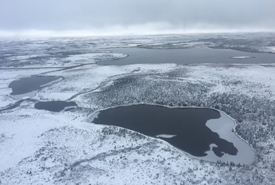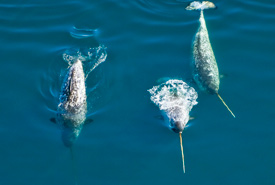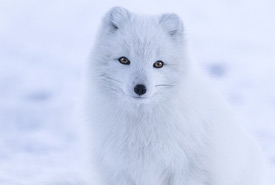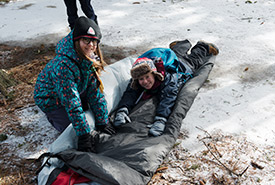Heard it from a Scout: Arctic action — a call for conservation

An aerial view of the Arctic landscape (Photo by NCC)
Each unique landscape in this world — whether it’s a forest, prairie, desert or the Arctic — plays a pivotal role in nature. The Arctic, in particular, supports a variety of flora and fauna while also helping to regulate global temperatures and circulate warm and cold currents.
Why the Arctic matters
Due to the Arctic’s harsh, cold climate and mysterious nature, it can be easy to forget that it is vitally important.
Part of the Arctic’s value lies in its biodiversity, geography and research potential. This diverse ecosystem is home to polar bear, Atlantic walrus and many types of whale and marine life, including the longest living vertebrate: Greenland shark. The abundance of species found in the Arctic, such as the many bird species that migrate to the Arctic to breed, allows for exciting research in the fields of polar and marine ecology, such as narwhal migration and distribution.

Narwhals (Photo by Mario Cyr)
The Arctic is extremely important to Canada, as it accounts for almost 40 per cent of our land mass and two-thirds of our coastline. It is home to northern residents and Indigenous Peoples, who rely on the ice for fishing and travel, and its animals for food and material resources. A healthy Arctic is key to the survival of their traditional way of life.
The Arctic is closely linked to global weather systems. Sea ice reflects about 80 per cent of the sunlight that hits it, which helps regulate climate by deflecting heat away from the ocean. When sea ice melts, the ocean absorbs about 90 per cent of the sunlight, which results in rising ocean temperatures.
Related content
Threats
The Arctic is vulnerable to many threats connected to climate change. Arctic ice is melting, and the region is warming at a rate twice that of the global average.
Climate change is the key threat in the Arctic. Sea ice provides a platform for seal, polar bear and other animals to hunt and rest. With less ice, it is harder for them to find food, causing them to travel greater distances and putting them at risk of exhaustion. There is also higher competition for food, as other predators from the south move north and encroach on the territory of Arctic species, as the once harsh environment warms and becomes more habitable. For example, the red fox has been increasingly moving north, which creates competition for Arctic fox.

Arctic fox (Photo by Jonathen Pie)
Decreasing ice means that there is increased potential for offshore oil and gas drilling in the deep sea. Due to the vast size and remote location of the offshore rigs, if an oil spill were to occur, cleanup would be extremely difficult. There is also very little infrastructure in the North, which, when combined with extreme weather conditions, would make it difficult to manage and respond to spills that may occur.
These habitat changes also affect the communities that call the Arctic home, as many Inuit and northern residents rely on these animals for food and the sea and ice for fishing and travel. Climate change can also have health effects on communities in the North, as an increase in extreme weather conditions can affect water quality.
Call to action

One of the main values in the Scouting movement is environmental stewardship, and this includes looking after the Arctic. (Photo by Scouts Canada)
Due to its unique geography, biodiversity and role within the planet’s climate balance, the Arctic is extremely important. Amid increasing threats, there is a greater need now more than ever to preserve and protect the Earth’s great North. One of the main values in the Scouting movement is environmental stewardship, and this includes looking after the Arctic.
There are many ways that Scouts and other youth can contribute to ensuring the protection of the Arctic. These include getting involved in movements like Earth Hour, which cuts electricity usage, and National Sweater Day, which encourages people to wear sweaters rather than turning up the heat during the winter. Both initiatives help reduce a person’s carbon footprint. Other small, easy-to do tasks that people of all ages can do include taking public transportation and using green energy, such as solar or wind power.
As today’s leaders and tomorrow’s change-makers, youth play an important role in environmental protection and can help restore a healthy planet and healthier Arctic.
"Heard it from a Scout" is written by members of Scouts Canada’s Youth Spokesperson program. This post was authored by Stephanie Aultman.


